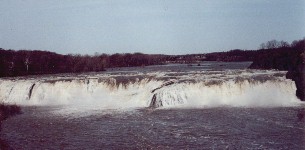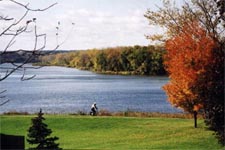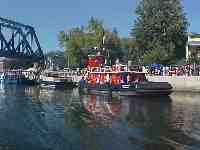History of the Communities
- Cohoes
- Colonie
- Green Island
- Troy
- Waterford
- Watervliet
Cohoes
The dominant landmark in the City of Cohoes, The Spindle City, is the 86-foot Cohoes Falls, the second most powerful waterfall east of the Mississippi. The Harmony Mills were the largest textile mills in the world when constructed, and the mills and the canal that powered them were an industrial marvel studied by engineers all over the world. Cohoes was known as a typical "company town" by the end of the Civil War, as every mill in Cohoes was under the ownership of the Harmony Company, whereas each of the other cities had a wide variety of owners of manufacturing companies. Also, the Harmony Company alone provided employee housing, some of which stand today.
|
 |
 |
 |
Colonie
During the Civil War, Colonie was widely known across the country as West Albany. It was known at one time as the "Wild West of the East," as its stockyards were the largest between Chicago and the Atlantic Ocean.
The Erie Canal opened in Colonie in 1825. A series of locks from Maplewood on the Hudson River through Cohoes to Colonie lifted the river barges the greatest elevation of any system of locks along the entire 300-plus mile length of the Erie Canal.
The first passenger train in America ran through Colonie in 1831 on its epic 18-mile journey from Albany to Schenectady along the rails of the Mohawk and Hudson River Railroad. By 1854 the New York Central Railroad purchased 350 acres of land which grew into the West Albany shops, a major repair center for the New York Central Railroad, employing as many as 2000 people. |
Green Island
Industry on Green Island has long centered on transportation and related businesses. To keep up with changing times, the Eaton Gilbert & Company converted to the manufacture of ornate railroad passenger cars in the 1850's. Near by, the Delaware and Hudson Railroad bought the Rensselaer & Saratoga Railroad shops and used them a major locomotive repair center until a larger faculty was built in Colonie. Across the street, Henry Ford built a radiator and spring factory powered by a new dam on the Hudson. The coach factory, railroad shops, Ford factory and a New York Central freight house still stand today and most are still used by other industries. |
|
 |
Troy
Troy was a major transportation hub at the beginning of the industrial revolution. Local iron works, shipped horseshoes, railroad rails, spikes, rivets around the world. The invention of the detachable collar in Troy started the city's textile industry. By 1840 Troy was had the forth highest per capita income in America. When fire destroyed most of the city in 1863, the citizens rebuilt in under a year, producing Troy's uniform architecture. As a high tech area of the industrial age, the need for scientists created the need for educational institutions. Rensselaer became a premier engineering university, while the Sage and Emma Willard Schools were at the forefront of women's education. |
 |
Waterford
First settled in the 1630s, Waterford is located where the Mohawk River enters into the northern most navigable point on the Hudson. The settlement was laid out in May 1783, on the former site of Half Moon Point. The village flourished as a river port in the late 1700s with flour mills and barrel making firms. It became a bustling canal town with the completion of the Champlain and Eire canals in 1823. It continues to be closely linked with the canals today, including the third branch of the Erie Canal, now part of the New York State Barge Canal. Nearby are preserved sections of the historic Eire and Champlain canals. The village of Waterford is the oldest incorporated village in the state of New York (chartered in 1794). |
Watervliet
Known for many years as West Troy, the history of Watervliet is closely linked with the development of the U.S. Arsenal, first established in 1813. Presently, the Arsenal located there is the only cannon factory in the nation. The Erie Canal sidecut also brought businesses and materials to the area, while other local industries gained international reputations for the quality of the products.
The Jones Car Works began to manufacture carriages and in 1859. It shipped hundreds of lumber and express wagons to California during the gold rush of 1848, but by 1880 the firm was near bankruptcy. It turned to making new electric trolley cars and soon had a global reputation for quality and efficiency. In a single order, the firm shipped 600 trolley cars to Bombay Tramway Company in India. Others went to Canada, South America, Europe and Asia. |
|
|